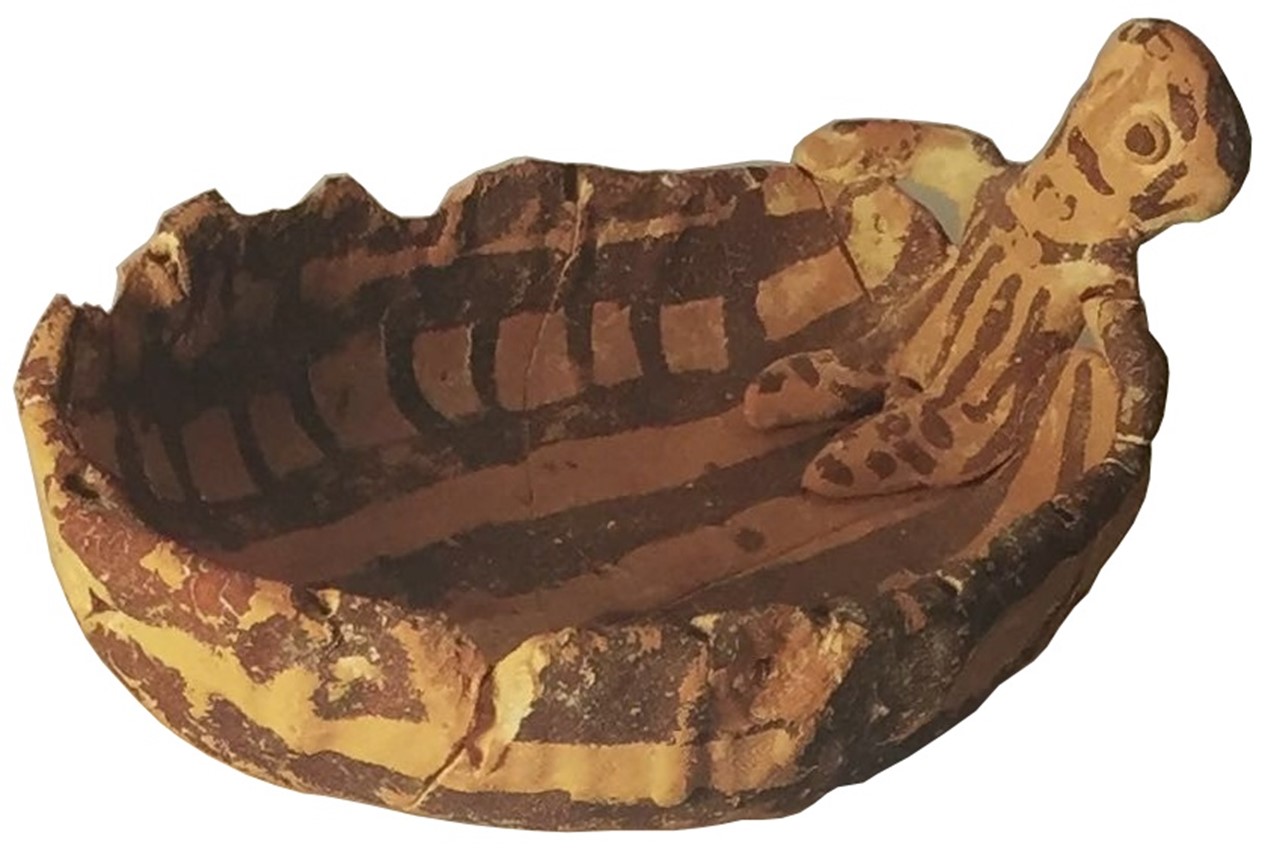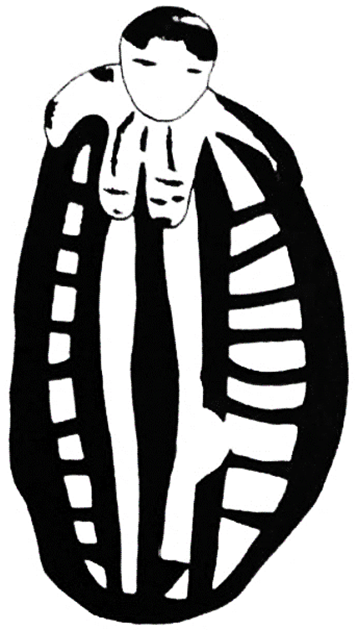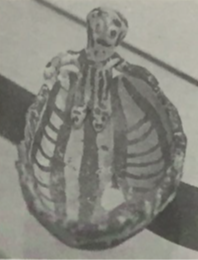Flat bottomed, beamy symmetrical hull with an irregular gunwale bearing the overall resemblance of a basket. On the outside, two horizontal painted bands - one along the gunwale or cap rail, the other lower down the hull possibly delineating strakes or strake joints. On the inside, three axial longitudinal lines (keel and keelsons), followed by a series of short vertical lines on either side (ribs/frames ?), and two more longitudinal lines above them at gunwale and cap rail level. The frames extend above the gunwale line, thus possibly serving as rail stanchions. On the opposite side of the figure, there are two holes, one on the rail itself, and another further below at the point where the hull curves upwards (forefoot). Six more holes along each rail. Painted male figure sitting at one end, arms outstretched resting on the rail.
Ship model
A35
PG - LG
Tomb X, Fortetsa cemetery, Knossos
L: 11cm; W: 6.5 cm; H: 2.5 cm
terracotta model, buff clay with details in dark brown varnish. Chips on the gunwale, small piece missing aft from the hull
Heraklion Museum P 14813
Basch 1987: 159-160, no. 321; Brock 1957: 41-43, 53, 143, pl. 36; Chatzidimitriou 2010: 14, fig. 27; Göttlicher 1978: 63, no. 327; Gray 1974: G21, no. D2; Greenhill 1976: 159, fig. 110; Johnston 1985: 39-40, Geom. 1; Morrison and Williams 1968: 17, pl. 1f; Snodgrass 1971: 82-83; Spathari 1995: fig. 60; Stampolidis 2003b: 46, fig. 3; Wedde 2004: 146
From a disturbed tomb with multiple burials. The boat model was found amongst a mass of miniature vases and clay objects, such as a snake coiled in a tiny bowl, a bowl with birds around the rim, a tree with birds perched on its branches, a miniature double aryballos. These are speculated to be a child's toys, perhaps buried in pithos 15 which was exceptionally small.
This model is unusually detailed from the point of view of constructional details. The hull's symmetry and lack of post decorations precludes a definite differentiation between bow and stern. The hole at the forefoot was possibly a string hole for dragging the model if a function as a toy is accepted. The holes around the rail may have served for attaching additional elements. The fact that the painted vertical lines on either side of the hull do not extend to the keel poses a problem for their interpretation as frames.
Basch, L. 1987. Le musée imaginaire de la marine antique. Athens: Institut Hellénique pour la preservation de la tradition nautique.
Brock, J. K. 1957. Fortetsa. Early Greek Tombs near Knossos. Cambridge: Cambridge University Press.
Chatzidimitriou, A. 2010. “Transport of Goods in the Mediterranean from the Geometric to the Classical Period. Images and Meaning,” Bollettino di Archeologia on line I.Volume speciale B / B3 / 1: 1-20.
Göttlicher, A. 1978. Materialien für ein Korpus der Schiffsmodelle im Altertum. Mainz: Philipp von Zabern.
Gray, D. 1974, Seewesen. Göttingen: Vandenhoeck und Ruprecht.
Greenhill, B. 1976. The Archaeology of the Boat. A New Introductory Study. London: A. and C. Black.
Johnston, P. F. 1985. Ships and Boat Models in Ancient Greece. Annapolis: Naval Institute Press.
Morrison, J.S. and R.T. Williams. 1968. Greek Oared Ships: 900-322 B.C. Cambridge: Cambridge University Press.
Snodgrass, A.M. 1971. THR Dark Age of Greece. An Archaeological survey of the eleventh to the eight centuries BC. Edinburgh: University Press.
Spathari, E. 1995. Sailing through Time: The Ship in Greek Art. Athens: Kapon Editions.
Stampolidis, N.C. 2003b. “Mia perileptike matia ste Mesogeio tes proimes epoches tou Siderou (11ος-6 ος p. Ch),” in N.C. Stampolidis (ed.) Sea Routes: From Sidon to Huelva. Interconnections in the Mediterranean 16th-6th c. B.C. Athens: Museum of Cycladic Art, pp. 41–79.
Wedde, M. 2004. “The Late Geometric Ship from Khalasmenos,” in N. C. Stampolidis and A. Giannikouri (eds.) Το Αιγαίο στην Πρώιμη Εποχή του Σιδήρου: Πρακτικά του Διεθνούς Συμποσίου, Ρόδος 1-4 Νοεμβρίου 2002. Athens: University of Crete, pp. 143-148.






